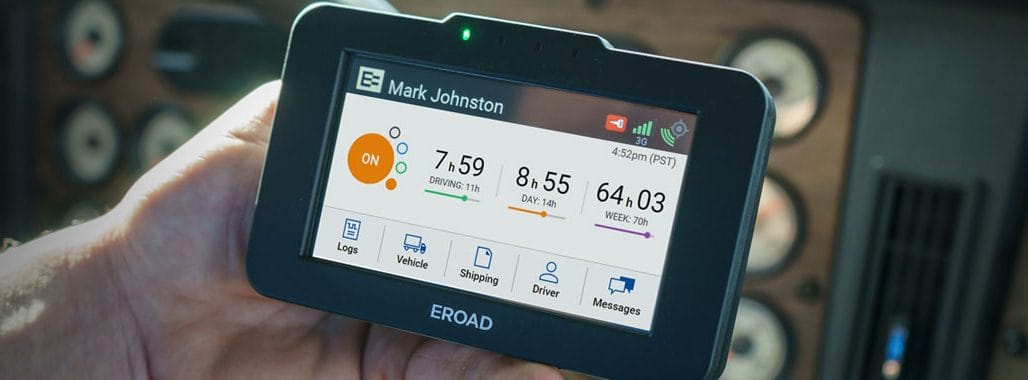If you own or manage a transportation company, you might be wondering, “What is the ELD mandate?” For starters, an ELD is an electronic logging device. It tracks the behavior of a vehicle whenever the engine is running to ensure an accurate recording of the driver’s hours of service (HOS).
The ELD mandate, on the other hand, is a federal rule that requires all commercial trucks to have an ELD installed at all times. The companies employing those truck drivers are required to keep a digital log of the ELD data as well.
The ELD mandate went into effect in December of 2017, though updates do arise every now and again. Here’s everything you need to know about the ELD mandate in order to make sure you and your drivers are in compliance with these laws.
And when you’re finished reading, check out the other articles in our ‘All about ELDs’ series:
- What is the ELD Mandate?
- What happens if you unplug your ELD?
- ELD exemptions: What you need to know
- 6 best trucker ELD providers
How Does the ELD Mandate Work?
The ELD mandate applies to all motor carriers, drivers, and operators who are responsible for maintaining records of duty status (RODS). It also applies to commercial busses, trucks, and modes of transportation that traverse Canada and Mexico.
Under the ELD rule, there are four main requirements that must be followed.
- All drivers that track HOS and RODS must do so via an ELD.
- All ELD devices must be certified and registered with FMCSA.
- Drivers and carriers must keep certain documents on file for their records.
- Drivers cannot be harassed based on data stemming from their ELD or other connected devices. If a driver does undergo such harassment, the law also outlines the recourse for the driver.
What Are the New ELD Laws?
Since the law was enacted, legislators have made some adjustments. Now, ELD devices and their tracking technology are required to adapt so that they meet the new rules. In September of 2020, the Federal Motor Carrier Safety Administration (FMCSA) updated the hours of service requirements, which includes the following provisions.
- The thirty-minute break requirement can be satisfied as either on-duty or off-duty status.
- The sleeper-berth rule can now break the ten hours off-duty time into two periods. Those periods can be split into 8:2 or 7:3. These hours will not count towards a driver’s fourteen-hour shift.
- The adverse driving conditions exception extends the maximum window of time that the driver is permitted.
- The maximum on-duty period has been expanded to fourteen hours for short-haul exceptions. It also extends the distance to 150 air miles.
Is an ELD Mandatory?
Yes, commercial motor vehicle drivers must use an FMCSA-compliant ELD device. Only a few drivers and vehicles are exempt from this law. According to the FMCSA, the goal of the federal law is to “help create a safer work environment for drivers, and make it easier and faster to accurately track, manage, and share records of duty status (RODS) data.”
Who is Exempt From Using an ELD?
There are several vehicle classes that the ELD mandate does not apply to, including:
- Short-haul drivers operating in a 100-air-mile radius
- Drivers using RODS no more than eight days out of a thirty-day reporting period
- Driveaway-towaway operators
- Drivers of vehicles manufactured before the model year 2000
Can Truckers Still Use Paper Logs?
The only truckers who can still use paper logs are those who operate vehicles that were manufactured before the 2000 model year. All other drivers must comply with the electronic log mandate rule.
Can I Use My Phone With an ELD?
Yes, under the ELD Section 395.22(g), you can use an ELD on your smartphone as long as it meets the FMCSA requirements and technical specifications. You must mount your smartphone in a fixed position that the driver can view while seated and operating the truck.
Things to Consider With the ELD Mandate
As you continuously ensure that your company is meeting the ELD mandate requirements, keep these factors in mind.
HOS Alerts
Before you face violations, get an alert when a driver is nearing their hours of service limitations. If you can get the driver to stop driving before he or she violates the hours of service regulations, then you can avoid penalties and fines.
Offline Reliability
Many drivers pass through parts of the country where cell service is not good. For the best results, select an ELD that has a good offline mode that can be synced via Bluetooth or USB. That way, you won’t lose any data, and the device will return to real-time data updates once it is back online.
Driver Communication
Some ELDs also include driver communication tools so that your office can stay in touch with drivers and help reroute them in the event of bad weather or heavy traffic. Allowing drivers and administrators to communicate through the same app that is connected to their screen will improve communication overall.
Easy-To-Read Data Log
Now that all log data is required to be digital, you’ll want to ensure that your ELD device makes it easy to download and store the log’s data. Many devices will only hold this data for anywhere from thirty to sixty days. Before that period of time comes to an end, you’ll need to download the records and store them securely for compliance purposes.
Inspection Reports
The more information that you keep in one system, the easier your documentation processes will be. Allowing drivers to complete their daily driver vehicle inspection reports within the ELD app will aid you in the process of monitoring your vehicles for defects and ensuring proper documentation is maintained. This is one more way that drivers and office staff can stay in constant communication using an ELD app.
Advantages of ELD Mandates
While the ELD mandate resulted in added expenses for trucking companies, especially the smaller organizations, the mandate does offer some advantages. Here’s a look at some of the ways that the mandate can benefit trucking companies and their drivers.
Simple Administration
Since an ELD tracks a truck’s movements and location, it can become easier for your office staff to know where your drivers and their trucks are at all times. You can also keep the receiving company updated about delivery timelines and expectations.
Using paper logs to manage the hours of service for your drivers is a huge administrative burden because it requires a lot of manual labor. Now all of those records are digital, they are much easier to store. When trucking companies utilize the services and features offered by an ELD, these companies can save time and money.
Vehicle Diagnostics
An ELD does more than just track the hours of service in a digital format and make sure companies meet the compliance requirements set forth by the ELD mandate. The ELD device also provides valuable data and insights to the trucking company team, like vehicle diagnostics for instance.
The administrative team can anticipate a truck’s maintenance needs in real time thanks to ELD’s alerts and reports. That way, companies are less likely to end up with trucks broken down on the side of the road, which would cause delays for shipping companies and harm business relationships.
Improved Efficiency Through Route Management
With an ELD, you can base your drivers’ routes in a way that optimizes fuel consumption, aligns with weather patterns, receives traffic alerts, and more. Thanks to better route management, you can save money and ensure timely deliveries, ultimately resulting in better relationships with shippers.
Your office staff will no longer need to call truck drivers to figure out where they are or learn about real-time delays. Instead, you can see where your drivers are and view where they’ve traveled so far. You can also save on fuel by using the features of an ELD, which will increase your profits by getting trucks to their destination even faster.
Disadvantages of the ELD Mandate
ELDs offer many great benefits, but they can also come with serious disadvantages. The more you know about these disadvantages, the easier it will be for you to deal with them should they arise.
Cost
Paying for ELDs for your fleet will require serious upfront costs in addition to monthly subscription fees. Look for ways to offset these costs by taking advantage of all of the features that the ELD offers.
You can reduce your administrative staffing with ELDs because they require less manual work, or you could even utilize the ELD to optimize your routes in a way that increases income without paying additional drivers.
Device and Technology Training
While technology can make for incredible conveniences, there is always a learning curve involved. You’ll need to train your office staff and drivers on how to use the ELD and its associated apps.
You more than likely won’t see route optimization and fuel efficiency in the early days after introducing the ELD to your team. And any time you bring on new staff or drivers, you’ll need to take time to train these people on how to use the technology as well.
Privacy
With an ELD, your drivers might feel like you’re always watching them, and it might make them think that they’ve lost their privacy since you’ll be able to monitor their every move. While this might not be a comfortable feeling at first, it is now part of the job. Drivers will have to adjust and view this aspect of their job as a benefit rather than a disadvantage.
ELD Mandate Compliance
The trucking industry is now a few years into the adoption of the ELD mandate. As such, everyone is still learning to adjust to the new requirements. The mandate produces both advantages and disadvantages for trucking companies and drivers alike.
FAQ
The ELD (electronic logging device) Mandate aims to improve road safety by ensuring drivers adhere to Hours of Service rules. The mandate requires electronic tracking of driving hours to prevent fatigue-related accidents.
Certain trucks can operate without an ELD if they meet specific exemptions, such as short-haul operations or using vehicles manufactured before 2000. However, most commercial trucks are required to have an ELD.
Vehicles that require an ELD are generally commercial trucks and buses that operate across state lines. These must comply with the Federal Motor Carrier Safety Administration’s hours of service regulations.


